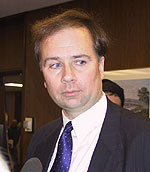Ventura releases bonding plan
By Michael Khoo
Minnesota Public Radio
January 14, 2002
|
| RealAudio |
Gov. Jesse Ventura Monday recommended the state borrow nearly $750 million to pay for long-term capital investments over the next five years. The bonding bill is considerably larger than the package Ventura submitted just two years ago, but Senate DFLers are already saying it's too small. House Republicans, meanwhile, are worried it's too hefty. House and Senate both say the proposal leaves roads and bridges underfunded.
| |
|
|
|
||
Before revealing his bonding recommendations, Gov. Ventura predicted he'd be the target of political sniping. He noted that lawmakers have already begun referring to proposed spending reductions and tax hikes as "Jesse cuts" and "Ventura taxes." But he says his $750 million borrowing package wasn't designed to win political points.
"Clearly, if I wanted to be Santa Claus, I could have signed off on $2 billion worth of requests, because that's how many we had. But I didn't run for this job to get my name on a building or to be fiscally irresponsible," Ventura said.
The bonding bill authorizes the state to borrow funds for investments with long-term significance, everything from building renovation and repair to transportation projects.
The single largest proposal on Ventura's list is $120 million for the Northstar commuter rail line, which would link St. Cloud and downtown Minneapolis. An additional $50 million is set aside for a northwest metropolitan busway.
Although public transit fares well, Ventura proposes relatively little for roads and bridges - a fact noted by House Capital Investment Chairman Jim Knoblach. Knoblach, R-St. Cloud, says House leaders will want to boost highway funding.
"The one thing that was the big surprise to me is that there's virtually nothing in here for roads and bridges. And we would have liked to have seen a lot more than that," Knoblach says. "I guess with no money for roads and bridges, this is actually probably a little bit on the high side from our perspective."
Ventura's plan allocates $30 million for local bridge repair, significantly less than what the Transportation Department had requested. The plan also calls for $85 million for a new laboratory to be shared by the Departments of Health and Agriculture. Ventura says the new facility would enhance the state's ability to respond to potential bioterrorist attacks.
Another $70 million is split between the University of Minnesota and the Minnesota State Colleges and Universities system to repair campus infrastructure.
| |
|
|
|
||
Senate DFLers have called for a larger bonding measure, one approaching $1 billion. Sen. Keith Langseth, who chairs the Senate Capital Investment committee, says he, too, was disappointed with the lack of highway funding. He says injecting cash into building projects could jumpstart a sluggish economy.
"You have a considerable number of people that are out of work. You have the contractors that are coming in with lower bids because they are not overwhelmed with projects. So I think a good time to bond and build is during tough times," Langseth says.
But Ventura says he's not persuaded by the economic stimulus argument. The governor says it takes time to move projects through the pipeline. He says historically, the majority of projects take several years to get off the ground even after they're approved. And he notes the state has seen several large bonding bills in recent years. If borrowing money primes the economy, he says, previously approved projects should already be making a difference.
"The 1998 bonding bill was the largest one in Minnesota history. And so if that's an economic stimulus - look where we're at," Ventura said. "Most of these projects are two to three years out, so, no, I don't look at it as necessarily an economic stimulus."
The governor's plan also denies funding to all local government requests. That means no new funding for, among other things, the Guthrie Theater, the Duluth Lift Bridge, or St. Paul's Roy Wilkins Auditorium. Lawmakers say such projects do have a place in the bonding bill - but would be lower on the priority list than more basic items like transportation, building renovations, and higher education.
More from MPRMore Information


